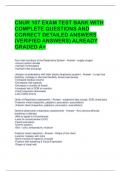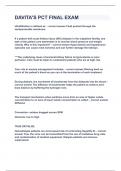CNUR 107 EXAM TEST BANK WITH
COMPLETE QUESTIONS AND
CORRECT DETAILED ANSWERS
(VERIFIED ANSWERS) ALREADY
GRADED A+
Four main functions of the Respiratory System - Answer- -supply oxygen
-remove carbon dioxide
-maintain homeostasis
-maintain heat exchange
Lifespan considerations with older adults (respiratory system) - Answer- -Lungs lose
elasticity, cartilage in ribs lose flexibility, bones lose density
-Increased residual volume
-Decreased vital capacity
-Decrease in number of alveoli
-Increased risk of SOB on exertion
-Chest expansion decreased
-Less mobile thorax
Order of Respiratory assessment - Answer- -subjective data (cough, SOB, chest pain)
-Posterior chest (inspection, palpation, percussion, auscultation)
-Anterior chest (inspection, palpation, percussion, auscultation)
General observation (respiratory assessment) - Answer- -Any obvious difficulty
breathing or distress
-Able to speak in full sentences
-Level of consciousness (LOC)
-Facial expression
-Client's position
-Skin - color, temperature, moisture
Posterior chest inspection - Answer- -Shape of the chest
-Lesions, masses, skin color
-Neck muscles & trapezius muscles
-Position with breathing & Facial Expression
-Shape of chest wall
,-Spinous process in a straight line
Posterior chest palpation- symmetrical expansion - Answer- -use hands, thumbs and
fingers
-place thumbs at T9/T10
-ask client to breath in slowly and deeply
-fingers should move away at the same rate
Posterior chest palpation tactile fremitus - Answer- -ask client to repeat phrases 99 and
blue moon
-start over the apices and palpate symmetrical and down
-use the palmer base of the hand to feel vibrations
Posterior chest palpation - Answer- note any:
-Tenderness
-Skin Temperature
-Moisture
-Lumps
-Masses
-Lesions
Posterior/Anterior chest percussion - Answer- -start at the apices and percuss along the
shoulders
-percuss the intercostal spaces
-percuss at 5cm intervals
-avoid bony areas
-18 times, 9 on each side
Posterior/Anterior Chest Auscultation - Answer- -slightly lean forward with arms at side
resting hands on lap
-breathe in and out deeper than normal through the nose
-listen to one FULL inhalation and exhalation
-put stethoscope directly on skin
-for anterior avoid breast tissue in women Anter
Bronchovesicular - Answer- -Moderate pitch
-Inspiration and expiration equal length
-Heard over major bronchi, on each side of upper vertebral column
Vesicular - Answer- -Low pitched, SOFT
-Rustling sound; wind in the trees
-Long Inspiration, short expiration
-Heard over lung fields
Anterior chest inspection - Answer- -shape of chest wall
-costal angle of 90
,-clients facial expression
-skin colour
-quality of respirations
Anterior chest normal auscultation findings - Answer- -Bronchial (tracheal)
-Bronchovesicular
-Vesicular
Bronchial (tracheal) - Answer- -High pitched, LOUD, harsh
-Heard over the trachea and larynx
-Short inspiration, long expiration
adventitous breath sounds - Answer- -abnormal breath sounds
-additional breath sounds
-crackles or wheezing
Fine crackles - Answer- -High-pitched, short crackling, popping sounds
-Heard during inspiration
-Not cleared with coughing
Coarse crackles - Answer- -Loud, low-pitched, wet bubbling sound
-Heard during inspiration and can extend into expiration
Wheeze - Answer- -High-pitched, musical sound
-Auscultated mainly during expiration; but may be present during inspiration
Stridor - Answer- -High-pitched, loud over neck
-Seal like sound
-Croup, obstruction
Plural friction rub - Answer- -Coarse & low-pitched, rubbing together (grating sound),
painful
Bronchophony - Answer- - client states "ninety-nine" each time you place your
stethoscope
- normal finding is muffled & indistinct sounds
- abnormal finding is very clear transmission of the words
Egophony - Answer- -client states "eeeeee" every time you place stethoscope
-normal finding is that you hear "eeeee" through stethoscope
-abnormal finding is the sounds of "aaaaaa"
whispered pectoriloquy - Answer- -client whispers phrase such as "one-two-three" each
time you place stethoscope
-normal finding is muffled, faint or almost inaudible sounds
-abnormal finding is very clearly heard words
, Veins in the leg - Answer- -calf pump
Veins in the leg (deep veins) - Answer- -femoral
-popliteal
Veins in the leg (superficial) - Answer- -great saphenous
-small saphenous
Veins in the leg (perforators) - Answer- -connects veins that join the two sets
-have one-way valves that route blood from the superficial veins into the deep veins
Three Factors of Venous Return - Answer- -Contracting skeletal muscles
-Competent valves
-A patent lumen
Main lymphatic vessels - Answer- -right lymphatic duct
-empties into the right subclavian vein
-drains the right side of the head/ neck, right arm, right side of thorax, right lung and
pleura, right side of the heart, and right upper section of the liver
-thoracic duct
-drains the rest of the body
-empties into the left subclavian vein
Lymph nodes - Answer- -arranged in groups
-filter the fluids and microorganisms before it is returned into the blood
Cervial nodes - Answer- -drain the head and neck
Axillary nodes - Answer- -Drain the breast and upper arm
Epitrochlear nodes - Answer- -Drains the hand and lower arm (Located in the
antecubital fossa)
Inguinal nodes - Answer- -drains most of the lymph of the lower extremity/the external
genitalia/the anterior abdominal wall
Considerations of older adults - Answer- -Blood vessels grow more rigid with age,
results in arteriosclerosis
-Intramuscular calf veins progressively enlarge with age
-Fewer numbers of lymph nodes are present
-The size of lymph nodes also decrease with age
Inspection & Palpation of the Arms - Answer- -Lift both the patient's hands in your hands
-Inspect color of the skin, and nail beds, anteriorly and posteriorly
-Inspect for Profile sign of the nail





